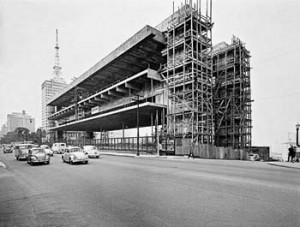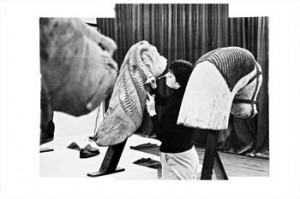
IMAGES RELEASE COSAC&NAIFYMASP under construction (1968)IMAGES RELEASE COSAC&NAIFY
Lina Bo Bardi (1914-1992), the Italian citizen born Achillina Bo, would have formed part of Brazil’s architectural history, if nothing else, for the landmarks she created and designed, especially in two major Brazilian cities: São Paulo and Salvador. Almost two decades after her death, her works, a notable blend of modern architecture and visual art, still fascinate her professional colleagues and the people who move about the spaces that she created. In the São Paulo state capital, she designed MASP, (the São Paulo Art Museum) and SESC-Pompéia. In Bahia, from 1986 to 1990, she drew up an important plan for the renovation of Salvador’s historical center, in which she advocated the conservation of the city’s “popular soul” by keeping the people living there in place. Here, her work encompassed the renovation of the steep Ladeira da Misericórdia street, with the Coati bar; the Sé Belvedere; the Barroquinha project; the Benin House; the Olodum House; and the Gregório de Mattos Theater, to name only some examples. However, when asked which had been her best project, she declared: “Perhaps, the most important is the miserable little chapel in the town of Uberlândia, built with no money, with the Franciscan priests and the prostitutes.” Lina, however, besides helping to make architectural history, changed everything around her in many other ways. She was an outstanding thinker and cultural agitator who tried to debate the most important themes in modern, urban culture.
The press and specialized magazines were fundamental for the dissemination of Lina’s thinking. In Milan, when she was barely over 25, during World War II (1939-1945), she joined her colleagues Bruno Zevi, Giò Ponti and Ernesto Rogers in writing seminal articles that advocated a contemporary and critical view of urban living. She also divulged architectural achievements and contemporary art in publications such as Domus and Lo Stile. Things were no different when she moved to Brazil after the war. In São Paulo, along with her husband Pietro Maria Bardi (1900-1999) – both of whom played a key role in the expansion of Masp, which they transformed from a little-known gallery into one of the finest collection of paintings south of the Equator – she directed the magazine Habitat, which became an important periodical in the 1950’s and 1960’s. In its pages, she voiced her advocacy for the European artistic avant-garde. In Salvador, side by side with intellectuals and foreigners connected with the University of Bahia, she planted the ideas that would become the basis for the New Cinema and Tropicalia movements.
The grandiose scale and extension of everything that Lina created and produced poses a challenge for many researchers. Part of this gap started being filled in the last few years thanks to theses about her. This is furthered by the release of the book Lina por escrito [Lina in writing], a selection of 33 articles published from the 1940s to the 1990s, selected by Silvana Rubino, a professor from Unicamp’s history department and a member of the board of governors of Iphan (the National Artistic and Historical Heritage Institute), along with architect and master’s degree candidate Marina Grinover, from USP’s School of Architecture (FAU). The volume includes original drawings, photos and graphic works by Lina herself, as well as some of the layouts she prepared especially for the original publication of her texts.

IMAGES RELEASE COSAC&NAIFYIn São Paulo: staircase from the glass houseIMAGES RELEASE COSAC&NAIFY
Regarded as sparse or inaccessible, her intellectual production draws our attention for the clarity and intelligence with which the architect tried, as the editors state, to sensitize the public to the poetics of simplicity, not as a means of recognizing poverty, but as something representative of the country’s wealth of diversity and culture. Thus, she explored the issue of the arenas of coexistence of free men, of edified memory, of folklore, while also contemplating the themes that permeated her profession: industrial design, the construction of housing, her affinity with popular art, museography, the city as a whole, and the conservation of the urban memory and historical landmarks.
Silvana Rubino narrates that her contact with Lina – whom she never met- is that of one who has specialized in Lina’s work and path. “Of course, at first, I admired her unthinkingly, because buildings such as Masp had been part of my urban and cultural experience.” An exhibition about Lina, along with the book edited by Marcelo Carvalho Ferraz (Lina Bo Bardi, Editora Imesp publishing house), awakened her desire to study Lina. The researcher tells us that the selection of articles resulted from conversations with Cristina Filho, who was in charge of books on architecture at the Cosac Naify publishing house. “I had defended my doctoral thesis (not yet published) about Lina’s path and talking to Cristina about gaps concerning architecture in the editorial milieu, we realized that a book containing all her articles was needed.”
At first, the two separated the texts by theme. “But we concluded that this way it would end up rather disproportional from the editorial point of view and we decided to put it all in chronological order, which enables the reader to follow the evolution of the architect’s thinking during the course of six decades.” Out of a total of 60 articles, 17 were excluded because they repeated ideas or themes and added little. Some, says the researcher, had become true “classics” of modern Brazilian architecture. Others were less well known. We chose a combination of articles about architecture, museums, folklore, cultural heritage, etc., published at different times during the course of Lina’s career.
These thoughts discuss a range of subjects, such as education, housing, popular art, etc. “The architect is an intellectual; devising a building, a city, is but thinking about the society in which he lives. Lina’s concerns were those of an intellectual of her time,” assess Silvana. The most revealing element, she adds, is that Lina constantly took a position in relation to architecture and to what her contemporaries were doing. Among the many articles, one of Silvana’s favorites is “Teoria e filosofia da arquitetura” [Theory and philosophy of architecture]. “When I read this handwritten lecture, with some rather Italianized words, I almost fell over backward. It was pure Antonio Gramsci translated into architects parlance! From then on, I started seeing with different eyes what she discusses, for instance, about popular art and, mainly, I started regarding her as an artist moving between different fields of knowledge.”

IMAGES RELEASE COSAC&NAIFYLina Bo Bardi restoring a figurehead from the São Francisco riverIMAGES RELEASE COSAC&NAIFY
Another essay that Silvana feels is relevant is “Cinco anos entre os brancos” [Five years among the whites], which the professor describes as a sort of testament-letter. It carries, says Silvana, “an acid, corrosive, non-anesthetized analysis” of the promises made prior to the 1964 coup, which did not come true because of the dictatorship that was established. “Roberto Schwartz wrote that Brazil was unrecognizably intelligent in the early 1960’s and somehow, in this text, Lina underlines this.” She does not talk about architecture, but about the “collective hopes that will not be deleted.” The article was published in 1967. “It is magnificent.”
Marina Grinover helped to prepare the book because Lina’s writings – her critical faculties, in particular – are the subject matter of her master’s degree at USP. As the collection is large, Marina says that there is sufficient content to organize further tomes. The institute has most of the magazines, papers and catalogs in which Lina’s texts were published as from 1941. It also holds a personal collection, whose manuscripts and letters are being organized. “By reading the set of texts selected by Professor Silvana, one can enter Lina’s thematic universe and realize that there is invariably a propositional touch concerning the ideas that permeated the generation of architects to which she belonged,” assess the researcher. These thoughts are connected with modern culture and its paradigms. “Lina always believed in the emancipating potential that art (and we can include architecture in this) has to make us develop a private and collective existence (in sum, life).”
A person who is highly familiar with Lina’s writings is Professor Vera Santana Luz, from PUC in Campinas, who in 2004 defended at USP her architecture and urbanism doctoral thesis, “Ordem e origem em Lina Bo Bardi” [Order and origin in Lina Bo Bardi], under the guidance of Rafael Antonio Cunha Perrone. At the time, she first consulted the formal collection arranged by Professor Sophia da Silva Telles, from PUC in Campinas, to which researchers had access. “The publishing of Lina’s writings in the form of a book is most important because it expands the range of access and possibilities of those interested in studying her work and her ideas.”
Vera draws attention to the fact that there is no paradox between Lina’s intellectual discourse and praxis. “Her thinking and the realization of her projects and designs have become one of the paradigms of modern twentieth century architecture, not only for her particular vision of the architecture that could be built in Brazil, but also of the international modern movement.” Her world vision of the role of architecture, the professor believes, is evidenced in everything she said, wrote and created. “I think that Lina managed to bring together universality and specificity – which in my doctorate I have referred to as order and origin, respectively – in the broadest sense of these expressions, without falling into regionalist schemes or empty generalizations.”
Republish
